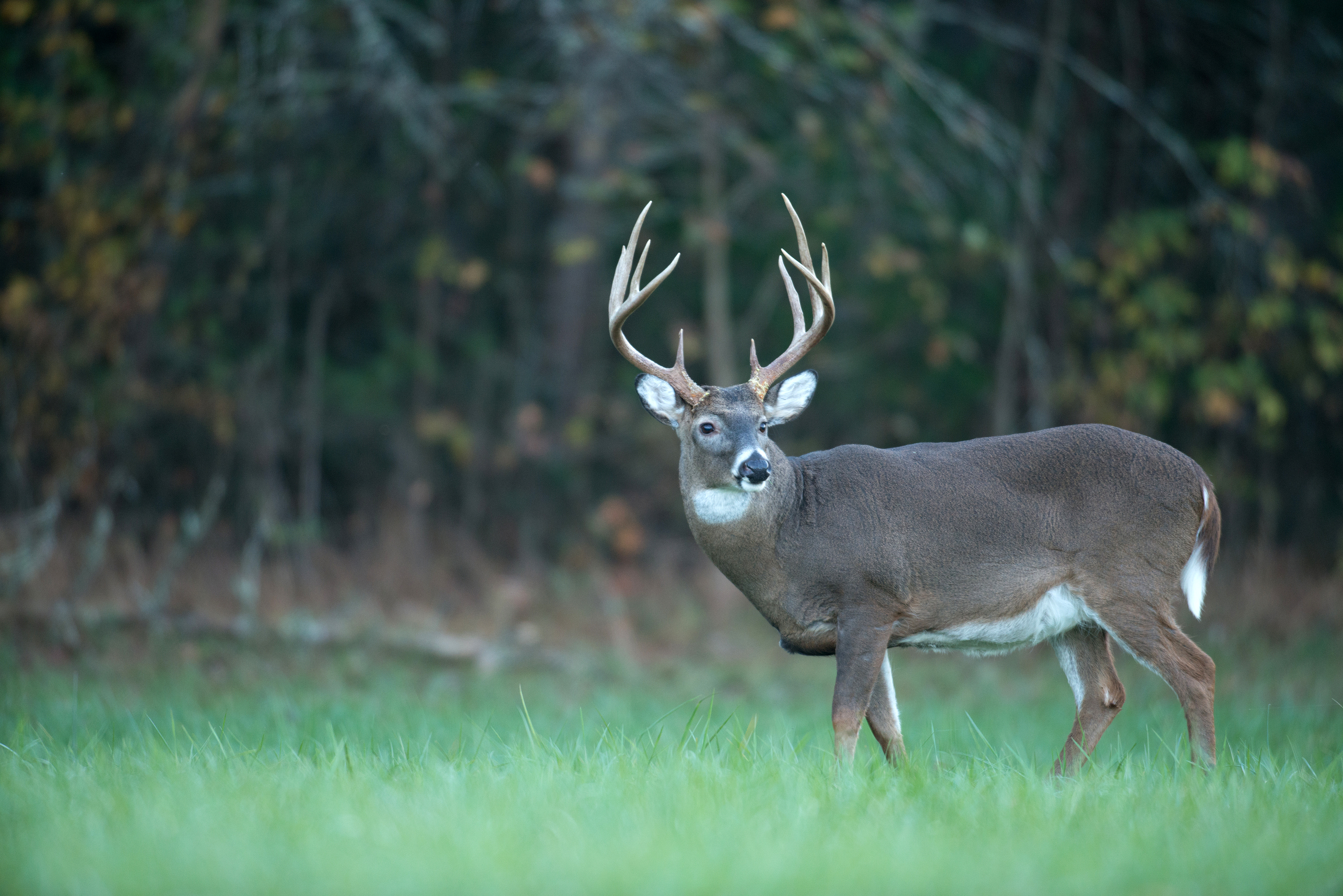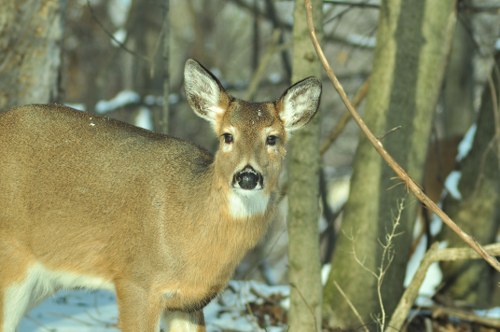
Superpower Senses and Anatomy of the Whitetail Deer
The Remarkable Anatomy and Senses of the Whitetail Deer: A Hunter's Guide
The whitetail deer (Odocoileus virginianus) is one of North America's most iconic and beloved wildlife species. These graceful creatures have captivated hunters, naturalists, and outdoor enthusiasts for generations. As any experienced hunter knows, successfully harvesting a whitetail deer requires not only skill and patience but also a deep understanding of the animal's anatomy and sensory capabilities. These animals know how to avoid predators and are built to deal with the elements in their environment. In this comprehensive article, we'll delve into the intricate details of whitetail deer anatomy, with a particular focus on their extraordinary senses of sight, hearing, and smell. We'll also explore how this knowledge can be applied to hunting strategies with insights from the experts at Rut Chasers, LLC

Anatomy of the Whitetail Deer
Before we dive into the sensory capabilities of whitetail deer, it's essential to understand their overall anatomy. Whitetail deer are medium-sized ungulates, with adults typically weighing between 100 and 300 pounds, depending on age, sex, and geographic location. They possess a number of physical adaptations that make them well-suited to their woodland and edge habitat environments.
Body Structure
The whitetail deer's body is designed for both speed and agility. Their long, slender legs allow for quick bursts of speed and impressive leaping ability, which are crucial for evading predators. The deer's muscular hindquarters provide the power needed for these swift movements, while their more slender forequarters allow them to navigate through dense vegetation with ease.
One of the most distinctive features of the whitetail deer is, of course, its tail. When alarmed, the deer raises its tail, exposing the white underside – a behavior that gives the species its common name. This "flag" serves as a warning signal to other deer in the area and can be incredibly frustrating for hunters who see their quarry alerting others to potential danger.
Coat and Coloration
The whitetail deer's coat changes with the seasons, providing camouflage and insulation appropriate for different times of the year. In summer, their coat is reddish-brown, which helps them blend in with the surrounding vegetation. As winter approaches, they molt into a grayish-brown coat that offers better insulation against the cold and improved camouflage in the barren winter landscape.
Antlers
Male whitetail deer, known as bucks, grow and shed antlers annually. These antlers are not just for show – they play a crucial role in establishing dominance during the breeding season or rut. The size and complexity of a buck's antlers typically increase with age, making trophy bucks with large antlers highly sought after by hunters.
Digestive System
Whitetail deer are ruminants, possessing a four-chambered stomach that allows them to extract maximum nutrition from their plant-based diet. This efficient digestive system enables deer to thrive on a variety of vegetation, from tender shoots and leaves to tougher bark and twigs when necessary.
Now that we have a general understanding of whitetail deer anatomy let's focus on their incredible sensory capabilities, starting with their eyesight.
Eyesight: A Deer's First Line of Defense
Whitetail deer possess some of the most impressive eyesight in the animal kingdom, which serves as their primary means of detecting potential threats. Understanding the intricacies of deer vision is crucial for hunters looking to outsmart these keen-eyed creatures.
Field of Vision
One of the most notable aspects of deer vision is their wide field of view. Thanks to the positioning of their eyes on the sides of their head, deer can see nearly 310 degrees around them without moving their head. This gives them a significant advantage in detecting movement and potential threats from almost any direction. In comparison, humans have a field of view of about 180 degrees.
Color Perception
Contrary to popular belief, deer are not colorblind. However, their color perception differs significantly from that of humans. Deer have dichromatic vision, meaning they have two types of cone cells in their eyes, compared to the three types found in human eyes. This results in deer being able to see primarily blues and greens, while reds and oranges appear more as shades of gray.
This understanding of deer color perception has important implications for hunters. While deer may not see blaze orange as brightly as humans do, they can still detect the unnatural patterns and outlines created by hunting clothing. This is why effective camouflage patterns that break up the human outline are so crucial.
Low-Light Vision
Whitetail deer possess excellent low-light vision, which is far superior to that of humans. This is due to several adaptations in their eyes:
- Large eyes relative to their body size, allowing more light to enter
- A higher concentration of rod cells, which are responsible for low-light vision
- A reflective layer called the tapetum lucidum, which enhances light sensitivity
These adaptations enable deer to be active during dawn and dusk, times when many predators, including human hunters, may have difficulty seeing clearly.
Motion Detection
While deer have impressive visual capabilities, they are particularly attuned to detecting motion. Their eyes are excellent at picking up even the slightest movements in their environment. This is why remaining still is so crucial when a deer is in your vicinity – even the smallest motion can alert them to your presence.
Hearing: The Deer's Early Warning System
If a deer's eyesight is impressive, its hearing capabilities are nothing short of extraordinary. Whitetail deer rely heavily on their acute sense of hearing to detect potential threats and communicate with other deer.
Ear Structure and Movement
Whitetail deer possess large, funnel-shaped ears that can independently rotate to focus on different sounds. This allows them to pinpoint the source of noise with remarkable accuracy. The ability to move each ear independently also means they can listen in two different directions simultaneously, further enhancing their ability to detect potential threats.
Frequency Range
Deer can hear a wider range of frequencies than humans. While the human hearing range is typically between 20 Hz to 20 kHz, deer can hear frequencies up to 30 kHz. This enhanced hearing range allows them to detect high-frequency sounds that might be inaudible to humans, such as the faint rustle of leaves or the subtle crunch of a twig underfoot.
Sound Localization
Thanks to the positioning and mobility of their ears, deer are exceptionally good at localizing sounds. They can determine not only the direction from which a sound is coming but also estimate its distance with surprising accuracy. This ability helps them decide whether to investigate a sound further or flee from a potential threat.
Vocalizations
While not as vocal as some other species, whitetail deer do use a variety of sounds to communicate. These include grunts, bleats, and snorts. During the rut, bucks may use a range of vocalizations to attract does or challenge other bucks. Understanding these vocalizations can be valuable for hunters, as it can provide insights into deer behavior and movement patterns.
Smell: The Deer's Secret Weapon
Of all the whitetail deer's sensory capabilities, their sense of smell is perhaps the most impressive – and the most challenging for hunters to overcome.
Olfactory Anatomy
Deer possess a highly developed olfactory system, characterized by a large nasal cavity and a vomeronasal organ (also known as Jacobson's organ), which enhances their ability to detect and process scents. The surface area of a deer's nasal cavity is estimated to be about 10 times larger than that of a human relative to body size.
Scent Detection Capabilities
Whitetail deer can detect odors at concentrations nearly 1,000 times lower than humans can perceive. This extraordinary sense of smell allows them to:
- Detect predators from great distances
- Locate food sources
- Identify other deer through their unique scent signatures
- Detect pheromones during the breeding season
Scent Processing
Not only can deer detect incredibly faint odors, but they also have a remarkable ability to distinguish between different scents and remember them. This means that a deer can potentially recognize the scent of a specific human or predator and associate it with danger.
Wind and Scent
Deer are highly attuned to wind direction and use it to their advantage when detecting scents. They often travel with the wind in their face, allowing them to smell potential threats ahead. This behavior is crucial for hunters to understand when planning their approach and stand locations.

Book Your Ohio Deer Hunt:
Email or Call us today at 419-543-3433
Beating the Senses: Strategies for Successful Hunting with Rut Chasers, LLC
Now that we've explored the remarkable sensory capabilities of whitetail deer, it's clear that successfully harvesting a trophy buck requires careful planning and execution. This is where the expertise of Rut Chasers, LLC comes into play. With years of experience and a deep understanding of whitetail deer behavior, Rut Chasers, LLC offers guided hunts and valuable insights to help you outsmart these keen-sensed animals.
Here are some key strategies to consider when attempting to beat the whitetail deer's impressive senses:
- Scent Control: Given the deer's incredible sense of smell, scent control is paramount. Use scent-eliminating sprays, wash your hunting clothes in unscented detergent, and store them in scent-proof containers. Consider using activated carbon clothing to absorb body odors.
- Play the Wind: Always be aware of wind direction and plan your approach accordingly. Set up your stand or blind downwind of where you expect deer to travel.
- Break Up Your Outline: Use effective camouflage patterns that match your surroundings and break up your human outline. Remember, while deer may not see colors the same way we do, they are experts at detecting unnatural shapes and movements.
- Minimize Movement: When in the field, move slowly and deliberately. Even the slightest unnecessary movement can catch a deer's eye and send them running.
- Use Natural Sound Cover: Take advantage of windy days or other natural sounds that can help mask any noise you might make.
- Employ Scent Attractants Wisely: During the rut, carefully placed scent attractants can help lure in that trophy buck. However, be cautious not to overuse them, as this can make deer suspicious.
- Understand Deer Behavior: Knowledge of deer habits, movement patterns, and vocalizations can give you a significant advantage. This is where the expertise of guides from Rut Chasers, LLC can be invaluable.
Conclusion
The whitetail deer's incredible senses of sight, hearing, and smell make them one of the most challenging and rewarding game animals to hunt. By understanding the intricacies of their sensory capabilities and anatomy, hunters can develop more effective strategies to outsmart these magnificent creatures.
Remember, successful deer hunting is about more than just beating their senses – it's about respecting the animal and the hunt itself. With the right knowledge, preparation, and perhaps a little help from the experts at Rut Chasers, LLC, you can increase your chances of harvesting that buck of a lifetime.
So gear up, study up, and get ready to put your skills to the test against one of nature's most impressive sensory machines. The challenge of outsmarting a whitetail deer's keen senses is what makes the hunt so thrilling – and the success so sweet. Happy hunting!

Book Your Ohio Deer Hunt:
Email or Call us today at 419-543-3433
 Prev Post
Prev Post




